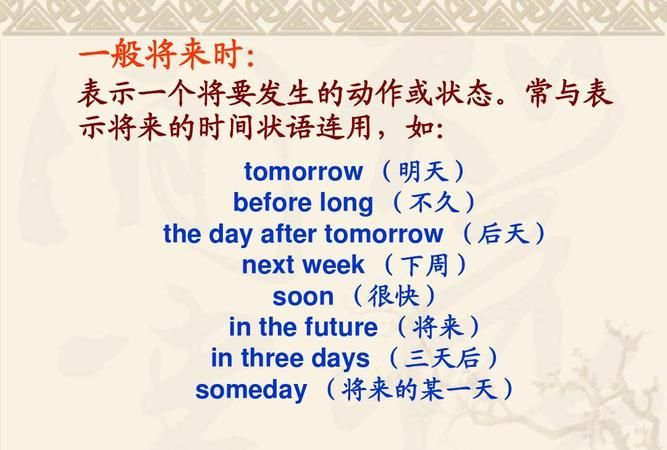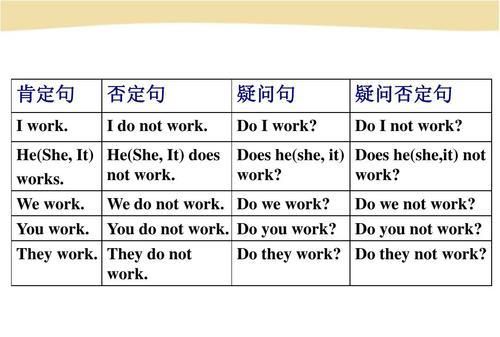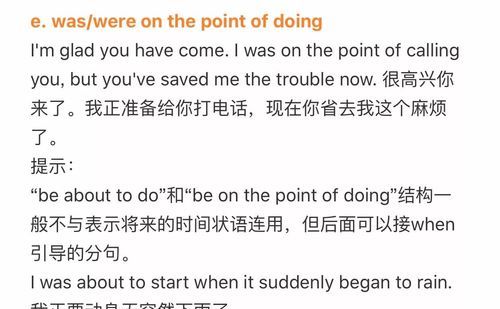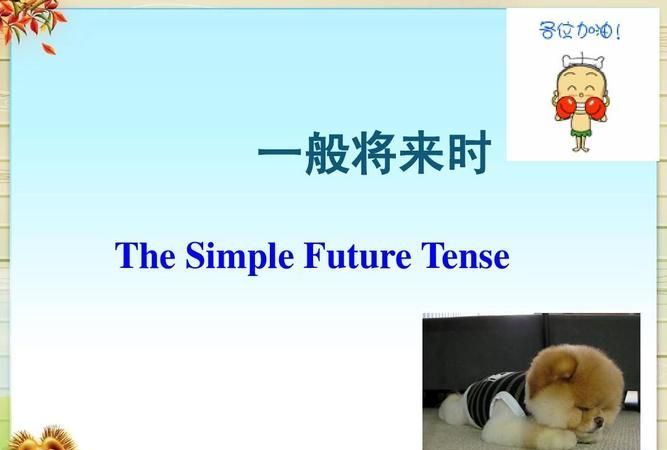本文目录
英语语法 英语时态 一般将来时的用法
应为英语语法中可以用一般时态表将来时态
下列动词come, go, arrive, leave, start, begin, return的一般现在时可以表示将来,主要用来表示在时间上已确定或安排好的事情。例如:
The train leaves at six tomorrow morning. 火车明天上午六点开。
When does the bus star? It stars in ten minutes. 汽车什么时候开?十分钟后。
2)以here, there等开始的倒装句,表示动作正在进行。例如:
Here comes the bus. = The bus is coming. 车来了。
There goes the bell. = The bell is ringing. 铃响了。
3)在时间或条件句中。例如:
When Bill comes (不是will come), ask him to wait for me. 比尔来后,让他等我。
I'll write to you as soon as I arrive there. 我到了那里,就写信给你。
4)在动词hope, take care that, make sure that等的宾语从句中。例如:
I hope they have a nice time next week. 我希望他们下星期玩得开心。
Make sure that the windows are closed before you leave the room. 离开房间前,务必把窗户关了。
——————
一、一般现在时主要用于:
1 、表示经常性或习惯性动作。 e.g. It seldom snows here.
2 、表示现在的特征或状态。 e.g. He is always ready to help others.
3 、普遍真理。 e.g. Action speaks louder than words.
4 、剧情图片介绍,背景说明,动作解说。 e.g. (Tom enters the room and sits at the table)
Doctor : What's your trouble, young man?
Tom : I've caught a cold, doctor.
5 、时间、条件、让步、方式状语从句表将要发生的动作时。
e.g. Tomorrow we shall go for an outing unless it rains.
与这种时态连用的时间状语常有: always, often, never, seldom, usually, once, a week, now 等。
二、一般过去时主要用于:
1 、表示过去某个时间发生的动作或情况(包括习惯性的动作或状态)
e.g. When did you read the novel? She often came to help us in those days.
2 、谈到过去的情况时 e.g. I didn't know you were so busy.
3 、谈到已死人的情况时 e.g. Lei Feng was a great communist fighter.
与这个时态连用的时间状语常有:
yesterday, last night, the other day, two months ago, in 1985, then, just now, when, after, as soon as 引导的时间状语从句,表示主句动作开始的时间。
三、现在完成时主要用于:
1 、表示到现在为止这一时期中发生的动作或情况,即多次动作的总和。
e.g. We have learnt four English songs this month. How many times have you read the novel?
For many days we haven't seen each other.
2 、表示对现在有影响的某一已发生的动作。
e.g. The delegation has left 代表团已经走了(说明现在不在这里) Look, what you have done. 看你干的事。
与这一时态连用的时间状语有: already, yet, just, ever, never, by now, so far, recently, by the end of this month, since, for 短语,连词 since 引导的时间状语从句。
一般过去时与现在完成时的区别:
一般过去时:重在说明动作在过去发生时的具体情况(时间、地点、方式、对象、细节等)。
现在完成时:只提起已发生的动作(事实)及其影响,不说明动作发生时的具体情况。
cf. Have you had your lunch? What did you have for lunch?
I have ever been to the Great Wall, and I went there last summer with my father.
注:现在完成时表达的动作常具有反复性,故下面一句是错的:
Have you seen the six thirty's news program? 应改为: Did you see the six thirty's news program?
四、现在完成进行时主要用于:表示过去开始的某一动作一直持续到现在,以至延伸到将来,它强调动作延续时间之长久。e.g. I've been writing an article. 我一直在写一篇文章。(还在写)
cf. I've written an article. 我写了一篇文章。(已写完)
It has been raining these days. 这些天一直在下雨。
五、过去完成时
1 、过去完成时是一个相对时态,表示过去的过去,只有在两个过去发生的动作相比较时才可显示出来。
e.g. As soon as we got to the station, the train had left.
注:主从句表达的动作紧接时,即两动作发生的时间没有明显时间上的悬殊或空档时,主从句都可用一般过去时。 e.g. Where did your brother study before he joined the army?
2 、过去完成时可表示截止过去某一时间动作的总或动作的结束。
e.g. By the end of last month. We had reviewed four books By eight o'clock, he had finished his homework.
与这个时态连用的时间状语常有: by 1985, by eight o'clock, by then, by the end of last month, by the time when, when, as soon as, before 等连词引导的时间状语从句,表示主句动作结束的时间。
(六)现在进行时主要用于:
1 、表示现在或现阶段正在进行的动作。 e.g. Listen, someone is crying. What are you doing these days?
2 、代替一般现在时,表示经常性动作或状态,而含有某种感情色彩。
e.g. How are you feeling today? 你今天感觉怎样?(显得亲切)
He is doing well in his lessons. 他的功课很好。(赞扬)
You are always boasting. 你老爱吹牛。(厌烦)
3 、动词 go, come, leave, arrive 等表将要发生的动作时。 e.g. They are leaving for Shanghai.
与这种时态连用的时间状语常有: now, these days, recently, this week 等。
七、过去进行时主要用于: 表示过去某个时刻或阶段正在进行的动作。
e.g. At that time she was working in a PLA unit. 那时她在解放军某部工作。
What were you doing this time yesterday?
与这个时态连用的时间状语常用: at nine o'clock, this time last night, these days, at that time 等。
用 when 引导的时间状语从句表示主句的动作正在进行的时间。
e.g. When he came in, I was reading a newspaper.
注:
1 、 while 引导时间状语从句叙述过去的动作时,从句常用过去进行时。
e.g. I read a magazine while I was waiting for the bus.
2 、 when 用作并列连词,意为“这时”,连接两分句时,第一句多用过去进行时。
e.g. I was reading a newspaper when he came in.
一般过去时与过去进行时的区别:
一般过去时:强调过去某一时间开始或完成的动作。
过去进行时:强调过去某一时间正在进行的动作。
试区别下面两句:
We were building a reservoir last winter. 去年冬天我们在修建一座水库。(可能尚未建成)
We built a reservoir last winter. 去年冬天我们修建了一座水库。(已经建成)
八、一般将来时主要用于: 表示将要发生的动作或情况
e.g. Tom will have a bike of his own.
与这个时态连用的时间状语常用: tonight, tomorrow, the day after tomorrow, next week, in three hours, two days later 等。
一般将来时态与其它结构表将来情况的区别:
一般将来时态 :主要从时间的角度表将要发生的动作或情况。
be going to 结构 :①表(主观上)打算或准备做某事时。 ②表有发生某事的预兆时。
e.g. They are going to have a competition with us in studies. It is going to rain.
据以上区别,故下面一句是错的:
I am going to be eighteen years old next year. 应改为: I shall be eighteen years old next year.
be about to do sth 结构 :意为“刚要做某事”、“马上要做某事”强调时间之紧迫性。
e.g. We are about to discuss this problem. 我们将马上讨论这个问题。
be to do sth 结构: 表示按计划、安排、规定将实施某事或表示注定会发生某事。
e.g. When is the train to leave. All these things are to be answered for

为什么在两时、两体的体系里面没有将来时了那英语的将来时放在哪里了
英语中没有将来时,只是通过各种语法手段来表示将来时间这个将来的时间概念。
现代英语动词体系只有一般现在时和一般过去时,进行体和完成体,没有将来时。英语动词的“时”和“体”属于两种不同的语法范畴,就英语动词的自身形式来说,没有能与现在时和过去时相提并论的动词形式“将来时”。英语中多种多样的将来时间表示法,其形态与英语动词的体一样,是一种复合形式。因此,我们应该从英语的语言实际出发,正确地掌握表示将来时间的方法,以利于指导我们的语言实践活动。
英语语法是针对英语语言进行研究后,英语语法系统地总结归纳出来的一系列语言规则。英语语法的精髓在于掌握语言的使用。

英语语法一般将来时
现在很多观点认为英语中没有将来时,只有表示将来的手段:进行时(情态动词+动词原形)或者其他形式。这些说法逐渐被广泛接受。我们初学者倒是不必在意这些的

为什么英语中没有将来时
英语里面这两个时态应该叫做过去将来时和一般将来时,一般将来时用以表示单纯的将来事实,常常用助动词will加上动词原形来表示,will常常简略成'll,will not常常简略成won't,和表示将来的时间状语连用,如:
He will come next week.
There will be no rain today.
I will catch up with you.
过去将来时用助动词would加上动词原形来表示,表示过去将来的某一时间发生的动作或存在的状态,常用在主句谓语动词是过去时态的名词性从句中,如:
You knew that I would come.
Never did we imagine that John would become a doctor.
I thought that you would take the chance.
He said he would come back the next day.
He said he would come back tomorrow.

以上就是关于为什么说英语没有将来时 ,英语语法 英语时态 一般将来时的用法的全部内容,以及为什么说英语没有将来时 的相关内容,希望能够帮到您。

